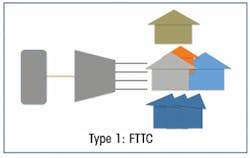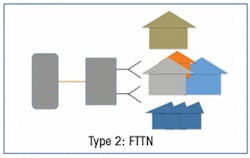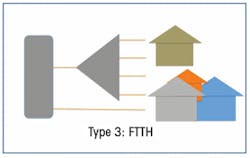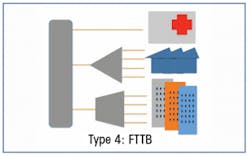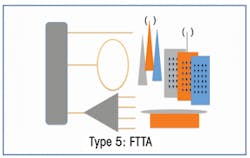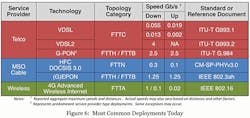Latest from FTTx/Optical Networks
FTTx Technology Advances Accelerate Broadband Deployment Growth (Part 1 of a 2-Part Series)
Broadband connectivity has become a fundamental part of our everyday lives. The first thing many of us do in the
morning as we wake up is to check our smart devices for updates on the news, weather, e-mail, or social media. Whether we are working from an office, home, or vehicle, we rely on almost constant connectivity.
Today network users require speeds that provide real-time communication up to 24/7, whether for our jobs or our personal lives. Already, deployment of Gigabit services to the home, multi-dwelling unit (MDU) and small business is accelerating rapidly. Deloitte Global predicts that the number of gigabit Internet connections will surge to 10 million by the end of 2016 — a tenfold increase — of which about 70% will be residential connections. Even more impressive, networks capable of gigabit connections will reach about 250 million subscribers worldwide.1
When we look at the state of broadband services today, many of us still see a large gap between the existing network performance and where we need to be. Some users are fortunate enough to live in metropolitan areas with access to 100 Mb/s or higher connectivity. But that access speed varies greatly across the country, and it largely depends upon the service topology the communications provider deploys in the area where we reside.
The network component that has made these high-speed networks possible is the use of fiber. There are 2 basic advantages of deploying fiber over both copper and coax technologies. Fiber has the ability to transmit much higher bandwidths (100 Gb/s deployment are very common today in metro networks); and it can transmit equivalent bandwidths much further distances. Today most access networks contain either a combination of fiber and copper or coax; or it may be all-fiber network deployment. These are referred to as Fiber-to-the-X (FTTx) networks.
This article looks at FTTx networks and will be presented in 2 parts. In Part 1, in this issue of ISE magazine, we look at FTTx access networks today: what they are, and how advances have been made to address the ever-increasing demands for higher-speed connectivity. Within that we look at each topology being deployed today, and the relative performance of each, and when and why each are selected.
Part 2, in an upcoming issue of ISE magazine, looks at the latest emerging bandwidth rich applications and markets that will stretch today’s FTTx networks beyond their current abilities. We will discuss emerging and evolving network standards work, and provide a view of the performance improvements to be expected. We will also look at how these new advancements complement existing FTTx topologies and investments.
What Is FTTx?
The rapid evolution we have seen over the last 10 to 25 years in communication technology illustrates how quickly our connected world has changed in a relatively short time. But it also gives us a glimpse of how staggeringly fast the rate is likely to continue in the months and years ahead.
The speed at which these technological changes are occurring is a continuous challenge for network equipment and service providers. They have to stay ahead of the technology curve of the evolving devices and apps in order to provide the speed and bandwidth in networks to support them.
FTTx represents a range of access network topologies. Access networks are the last segment between our local communications providers’ central offices, or head-ends, and our homes, multi-dwelling units (MDU), businesses, or wireless antennas. Today some of these networks consist of all fiber, while others are a hybrid mix of fiber and more traditional copper based elements. Hybrid networks transition from fiber to copper or coax at distribution points located closer to the premises they serve.
Let’s briefly look at each of the topology designs in predominate use today and the providers who deploy them. The 5 graphics shown provide a visual representation of each description.
There are 2 versions that are used to address both FTTH and FTTB applications. Point-to-Point (P2P) solutions provide 1 fiber all the way to each premises, which is most often found in FTTB applications. However, the more popular version for FTTH feeds fibers to a distribution point (PON splitter hub) where each fiber is split into multiple distribution fibers. Here 1 fiber connects each home or business. While various splitter ratios are used, typically 1 feeder fiber would serve 32 homes.
In business environments where higher dedicated bandwidth is needed (e.g., 1-10 Gb/s), course wavelength division multiplexing (CWDM) is often used. This integrates multiple data wavelengths on each individual fiber, each wavelength being assigned to a specific customer. Instead of splitting the data signal, CWDM de-multiplexes (separates) the multiple wavelengths into 1 individual wavelength per fiber. Each fiber then connects to its assigned customer location.
Type 5: Fiber to the Antenna (FTTA) FTTA is the youngest of the "x"s but no less important. It provides high-speed/bandwidth mobile access by feeding fiber to various types of antennas including cell towers, rooftops, distributed antenna systems (DAS), and Small Cells. While the majority of deployments support public mobile device access, some variants also provide high-speed broadband Internet services to rural or accessibility-limited environments.
Deployment Types of Each "x"
To understand the various FTTx topologies more clearly, comparing them to one another helps to determine which might be most appropriate and work best for a given area.
Deployment areas are commonly categorized in the communications industry as brownfield or greenfield. Brownfield is a term referring to previously developed areas where copper or coax plants are already in place, also commonly referred to as legacy systems. Greenfield refers to new areas of development or expansion where infrastructure is not yet in place.
FTTN and FTTC are most often deployed in brownfield areas in smaller cities, less developed areas, and rural communities; especially where there is little or no competition for FTTH services. This approach is driven by the higher investment required to run fiber all the way to each premises, versus continuing to use their existing copper or coax plant with updated end equipment to improve bandwidth speeds. These newer technologies enable service providers to offer basic to moderate levels of "broadband" speeds, but are relatively slower than their FTTH or FTTB counterparts.
Often these "adapted" networks are upgraded to FTTH or FTTB once a new market entrant offers a competitive service. Google Fiber is a recent example of a "competitive disruptor" in a number of markets. But without competition there is less motivation for incumbents to invest in moving to all fiber, except in geographic regions where populations or business densities may support a strong financial business case. In these areas FTTH/FTTB deployments are found in brownfield areas to enable access to premium high-speed services via fiber.
While telecom-based copper services remain relatively slower than their HFC counterparts, some of the newer services like DOCSIS 2.0 now provide "high-speed" broadband connectivity. Currently the FCC defines high-speed broadband as a minimum of 25 Mb/s downstream and 3 Mb/s upstream to each home.2
Greenfield deployments are almost exclusively FTTH or FTTB. Since cable has to be laid anyway to provide basic services to homes and businesses in newly developed areas, the business case for placing fiber is quite obvious. It even costs less to install fiber cables than copper due to its smaller size and weight.
Greenfield FTTH deployments also make good sense in terms of marketing the area to potential buyers and subscribers. Broadband Communities (BBC) recently reported that availability of fiber services added an average of 3.1% to home values. Fiber also commands on average 8% more to apartment rental values.3
Figure 6 provides a comparison among each deployment type and looks at aggregate maximum speeds and standards body references. Please note that in FTTC, FTTN and FTTH/FTTB (w/ splitter), actual speeds at each premises is typically much slower than aggregate speeds, as that bandwidth is shared among multiple users.
More recently FTTA supported services have extended to include a high-speed wireless Internet alternative in mostly smaller and underserved markets. A 4G alternative to wireline home services can provide speeds to each premises of up to 50 Mb/s downstream and 20 Mb/s upstream, which is competitive with most FTTC and FTTN deployments.
FTTA is now among the largest infrastructure investments being made by wireless providers. Fiber is used in the construction of new towers, but a large effort is in replacing coax equipped cell towers with FTTA. This not only enables much higher bandwidth capability than legacy coax, but it also dramatically reduces weight and power consumption of each tower.
With the large number of cell towers in place, there is an urgency to upgrade them to support these higher bandwidth demands. But FTTA is not just fiber-to-the-cell-tower. Distributed antenna systems (DAS) and Small Cells are also a key part of FTTA. These smaller antenna systems are being deployed en masse to blanket urban areas and fill tower and rooftop coverage gaps. They also provide coverage to office buildings, and are deployed in and around convention centers and sports arenas, and even inside tunnels.
Looking Ahead
The above topologies have been able to address most bandwidth demands we have experienced to date. However, they are not expected to support the much more demanding requirements of applications and services already beginning to emerge.
In the June issue of ISE magazine, Part 2 of this article looks at some of these emerging applications and services. We will discuss what comes next to keep us ahead of the bandwidth demand curve.
Endnotes:
1. Broadband Communities "2016 Forecast: Sunny with a Chance of Gigabits", Jan/Feb 2016.
2. FCC "2015 Measuring Fixed Broadband Report", December 30, 2015.
3. Broadband Communities "Fiber for the New Economy", November 2015.






